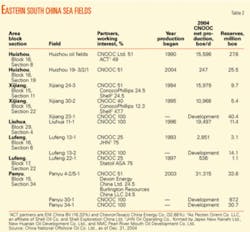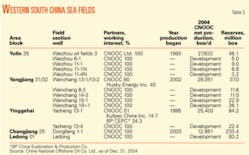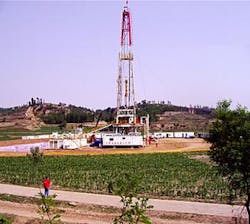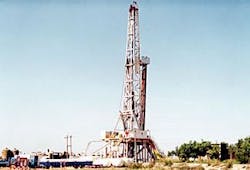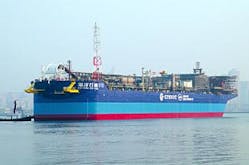China’s national and international oil companies are actively involved in exploration and development projects on and offshore China.
Commentaries attribute China’s quest for overseas petroleum to its lack of domestic oil and gas resources. But according to production figures from the US Energy Information Administration, China in 1998-2005 produced more oil than any OPEC country, except Iran and Saudi Arabia, more oil than Canada, the UK, or any Latin American or European country (Table 1).
Among China’s varied onshore petroleum resources are:
• The Daqing oil fields in Helongjiang Province, Manchuria, northeastern China, which began producing 1963.
• The Shengli field complex, centered on the Yellow River in Shandong Province, adjacent to Bohai Bay.
• Three basins in the Xinjiang Uygur Autonomous Region in far northwestern China (Tarim, Turpan, Karamay).
• The Changqing oil field in central China’s Shaanxi Province.
• The Sulige gas field in the Ordos basin, Inner Mongolia Autonomous Region, named China’s largest gas field in 2003.
• The Sebei gas field in the Qaidam basin.
Ismail Tiliwaldi, chairman of the Xinjiang Uygur region, said in mid-June that he expects it to become China’s largest oil-producing area in the next few years. Currently third in oil production, behind Daqing and Shengli, Xinjiang produced 22 million tons last year. Tiliwaldi said there are plans to increase production to 50 million tons/year and there is potential for 100 million, since Xinjiang has 30% of the country’s oil reserves and 34% of its natural gas.1
China’s offshore resources include the fields in the South China Sea (Tables 2 and 3); East China Sea (Xihu Trough and Chunxiao gas field); and Bohai Bay. Exploration and development in the South China and East China Seas have been hampered by territorial disputes. Sovereignty over the Spratly Islands in the South China Sea is disputed by China, Malaysia, the Philippines, Taiwan, Brunei, and Viet Nam. Recently, China, the Philippines, and Viet Nam have reportedly agreed to limited joint exploration. CNOOC, Philippine National Oil Co., and Vietnam Oil and Gas Corp. signed an agreement in March 2005 to jointly explore the oil potential of the islands and atolls in a 3-year seismic survey.2
Great Wall, ‘Changcheng’
China liberalized regulations on private investment in February 2005, allowing the establishment of the country’s first private sector oil company, the Great Wall Petroleum Group.
Great-Wall United Petroleum Co. (GUPC) will be the first nonpublic Chinese oil company to carry out oil and gas exploration projects.3 In late May, Gong Jialong, president of the China Chamber of Commerce for the Petroleum Industry, said that GUPC would be established in June as China’s fourth-largest oil conglomerate. It will represent more than 100 domestic privately owned oil firms, and raise about $604 million in operational capital.4
Domestic exploration and development drilling continues, as the country’s national oil companies are realigned. Four companies previously controlled the industry: China National Petroleum Corp. (CNPC); China Petrochemical Corp. (Sinopec); China National Star Petroleum Corp.; and China National Offshore Oil Corp. Ltd. (CNOOC).
China National Star was created in 1996 to introduce competition as China’s third national oil company. It began with $373 million in capital assets and a work force of 31,000 people from the former Bureau of Petroleum Geology and the Ministry of Geology and Minerals Resources.5
Beijing-based China National Star discovered oil in the Tarim Basin and in the East China Sea (Chunxiao gas field, estimated reserves of more than 1.6 tcf).
Sinopec
In March 2000, China National Star merged with Sinopec Group Co. (China Petrochemical Corp.) and was renamed Sinopec Star Petroleum Co Ltd., as China’s petroleum and chemical industries were restructured.6
Sinopec National Star drilled 221 exploration wells and 300 production wells onshore and 5 exploration wells offshore in the East China Sea during the 3-year period ending Dec. 31, 2000. As of May 31, 2001, Sinopec National Star had exploration licenses for 77 blocks (about 154,910 sq km) and development licenses for 24 blocks (about 2,721 sq km).7
In June 2001, Sinopec Corp. announced that it (China Petroleum & Chemical Corp.) had acquired Sinopec National Star Petroleum Co. from China Petrochemical Corp. for about $779 million, representing about $1.77/boe for proved reserves of about 622 million boe. The enterprise value of Sinopec National Star was about $1.1 billion, but it carried an estimated net debt of about $324 million.7
In late September 2002, Sinopec Corp. announced that it had drilled and completed 259 exploratory wells through August, including 132 successful wells (~51% success rate). The company controlled 787,800 sq km, comprising 93.9% land area and 6.1% offshore area, an increase of 280,000 sq km from the previous year.
Sinopec is the second-largest national oil company in China.
CNPC onshore
China National Petroleum Corp. (CNPC), the largest national oil company, operates 13 oil fields onshore China, primarily through subsidiary PetroChina Co. Ltd. The company had 641 drilling rigs, 584 crews, and drilled 7,095 domestic wells in 2003, including 481 exploration wells and 6,614 development wells. Total drilling footage increased 25% from 2002; 13,776 m were drilled in 2003.8
CNPC’s drilling research and development included six field experiments in 2003: gas well drilling in Yumen; slim hole drilling in Changqing; cased well drilling and radial horizontal well drilling in Jilin; underbalanced drilling in Sichuan; and multiple bottom and multiple branch drilling in Liaohe, Xinjiang, and Tuha fields.9
Experimenting with drilling technologies apparently paid off in Jilin Province: CNPC announced in late December 2004 that the annual crude oil production from the Jilin oil field was more than 5 million tons for the year. After 3 years of production increases of 300,000 tons/year, this was the highest production rate achieved in the 40-year history of the field.10
Underbalanced drilling
CNPC says its high-profile underbalanced drilling research project, “Study and Application of Underbalanced Drilling Technology in Sichuan Gas Reservoirs,” has proved to be worthwhile. The company listed the project in a news release as one of CNPC’s top ten scientific and technological events of 2004. It involved study and application of underbalanced drilling theories, software, techniques, and technologies, and development of facilities and equipment.
The company touted, in particular, its development of the XF-10.5/21 rotary BOP and the BY60/30-3500 pipe strings that are run without killing the wells.
CNPC said it drilled underbalanced wells on the Qiongxi structure in Luxian County, western Sichuan Province in 2003. The Qian-2 well was drilled adjacent to a dry hole but was completed underbalanced and successfully flowed 75,000 cu m/day. The Qian-4 well was drilled and completed underbalanced and successfully flowed 840,000 cu m/day.11
In 2004, CNPC affiliate PetroChina Southwest Oil & Gasfield Co. used underbalanced drilling in the Sichuan and Chongqing natural gas region. According to a late year press release, gas production from the area reached 10 billion cu m/year. The company drilled 50 additional natural gas wells with a production capacity of 2 billion cu m/year.
CNPC said in a January 2005 news release that 57 underbalanced wells were drilled in the west, central, south, and southwest parts of Sichuan basin, resulting in a “great breakthrough” in the exploration of the Qiongxi structure.
Horizontal drilling
Horizontal drilling has been used in China for more than 15 years. OGJ reported in 1991 that a surge of horizontal drilling hit the country and was being used in eight producing areas, including the Shengli complex (OGJ, Aug. 19, 1991, p. 30).
In 2003, CNPC drilled and completed 28 horizontal development wells in the Tarim oilfield in the Taklamakan desert of northwestern China, representing 34% of the total number of wells in the field but accounting for 45.4% of the total production.
According to a February 2005 news release, a single well in the Yingmaili area of the Tarim field produced 118 cu m/day from Cambrian carbonates. The Yingmai-32 well was spudded on July 10, 2004, on the west part of Luntai arch of Tabei uplift to test the Cambrian, along with the Neogene Jidike formation, Paleogene, and Cretaceous Bashijidike formation. It reached a TD of 5,432 m.12
In an April 2005 press release, CNPC said that the Tarim basin holds the biggest accumulation of oil and gas in China, containing proven reserves of 12.3 billion tons of oil equivalent and 8 trillion cu m of natural gas.
In the Jidong oil field in Hebei Province, CNPC says horizontal wells produced oil and gas at 3-4 times the rate for vertical wells. Horizontal completions also helped to control the high water cut in the field. On Dec. 29, 2004, CNPC announced that crude oil production from Jidong was more than 1 million tons/year. The company’s goal is to produce 1.5 million tons/year of oil from Jidong.
In late May 2005, Houston-based Far East Energy Corp. (FEEC) announced contracts with the No. 1 Drilling Co. of Zhongyuan Petroleum Exploration Bureau (ZPEB) to drill two long-reach, underbalanced horizontal wells in China’s Shanxi Province beginning in June 2005. ZPEB is a subsidiary of Sinopec.
The wells will be drilled in the Shouyang Block to about 550 m (1,800 ft) with up to 4,000 m of horizontal drilled laterals inside the coal seam for each well. Far East Energy farmed out its 4,280 sq km (1,057,650 acres) CBM project in Shanxi Province from ConocoPhillips.
The company says each well will take 35-60 days to drill and complete, after which they will de-water and test. NQL Drilling Tools Inc., a subsidiary of NQL Energy Services Canada Ltd., is providing directional drilling equipment, including its Black Max downhole tools. The first well, Shouyang FCC-HZ01 was spudded June 8, 2005 (Fig. 1). The FCC well designation stands for FEEC; China United Coalbed Methane Corp. Ltd.; and ConocoPhillips; HZ for the Hanzong mine area.
FEEC plans a third horizontal well in late 2005 in Yunnan Province, southern China under its 265,000-acre production sharing contract and will solicit bids this summer.
Shengli complex
One of several large onshore oil fields (Jidong, Dagang) on the western side of Bohai Bay, the Shengli field complex was discovered by the Hua-8 well in April 1961 and began commercial development in 1964. By the end of 2002, operators had discovered 71 different oil and gas fields, including one offshore field.
Chevron Overseas Petroleum Ltd. chose the Shengli area for its first onshore contract in China. The company signed a production-sharing contract in June 1997 with CNPC to explore for oil in the Zhan Hua Dong block (695 sq miles), intending to explore the pre-Tertiary section. Shengli’s shallow fields were producing 650,000 bo/d, China’s second-largest oil-producing area, after Daqing.13
Genting Oil & Gas China Ltd. (GOGC), a subsidiary of Malaysia’s Genting Oil & Gas Ltd., 95%-controlled by Genting Berhard, announced drilling results earlier this year from the Zhuangxi Buried Hill oil field, in the main producing area of the Shengli oil field, Shandong Province. The deep, hot field produces medium and light oil from Lower Paleozoic fractured carbonates and Precambrian granitic gneiss in the North Jiyang depression of the North China (Bohai) basin. Zhuangxi is adjacent to the Chengdao offshore field in Bohai Bay (OGJ, Aug. 19, 1991, p. 30).
The company drilled two deep wells in late 2004. The ZG10-18 development well reached TD at 4,848 m in fractured Precambrian granitic gneiss. The well was tested with a 25 mm choke and initially flowed 521 tonnes oil/day (more than 3,500 bo/day) and went on production with a 10 mm choke, flowing 200 tonnes oil/day.
GOGC drilled the ZG10-8 well to 4,721 m and it flowed 87 tonnes fluid/day from the entire Ordovician to Precambrian open hole section, with a 34% water cut, producing about 57 tonnes oil/day (390 bo/d). The company plans additional wells on the south side of the field this year, including the ZG13-1ST sidetrack on the north side of the field.14
GOGC said that production from the Zhuangxi Buried Hill field has averaged 300-400 tonnes oil/day for the last 4 years (Fig. 2). With the new ZG10-18 and ZG10-8 wells and other new projects, it expects total daily production of 600 tonnes/day (4,000 bo/d).
Genting is the operator and 100% interest holder in the Zhuangxi Buried Hill field contract, signed with Sinopec in 1999. The 20-year production period began Oct. 1, 2002.15
The Zhuangxi Buried Hill field averaged 2,597 bo/d in 2004, and the average price of Shengli crude $32.02/bbl, producing more than $15.4 million in revenue for GOGC.16
CNPC plans
In May 2005, PetroChina and Shell China Exploration and Production Co. Ltd. jointly announced the terms of the Changbei gas field development project.
The field underlies China’s Shaanxi Province and Inner Mongolia Autonomous Region, and the estimated initial gas production of 1.5 billion cu m/year (increasing to 3 billion cu m/year) is destined for sale in Beijing, Shandong, Hebei, and Tianjin. The $620-million project includes 53 wells to be drilled in a 10-year period.
The No.1 Drilling Co. of the Liaohe Petroleum Exploration Bureau has the contract for drilling rigs and services. The Drilling Co. of Changqing Petroleum Exploration Bureau received the contract for drilling fluids and services. Halliburton Co. will provide directional drilling, formation evaluation equipment, and services for the Changbei project.
Earlier in May 2005, CNPC announced a contract for coalbed methane drilling in the Qinshui basin of China’s Shanxi Province. PetroChina Co. Ltd. signed a contract on Apr. 29 with US-based CDX Gas LLC to drill “feathered” horizontal wells in two clusters for a CBM pilot.17
CNPC said China has the third largest coal resources in the world, with about 2.7 trillion cu m of gas estimated in strata shallower than 1,500 m. PetroChina hopes to establish 1 billion cu m/year production from the Qinshui basin block.
CNOOC operations
The China National Offshore Oil Corp. was created in 1982 to work with international companies to develop assets abroad and offshore China, including the South China Sea, East China Sea, and Bohai Bay to the north.
In 2001, the company floated a publicly traded subsidiary in Hong Kong and New York, CNOOC Ltd. The new company has aggressively brokered deals, with three big transactions since May 2004 for reserves off Australia (Northwest Shelf gas project) and Indonesia and in the Alberta oil sands. As recently as June 22, 2005, CNOOC has expressed interest in acquiring Unocal Corp., with a $19 billion bid. Chevron Corp. had already announced a $16.4 billion bid in May.
In mid-June, Business Week characterized CNOOC as “the most ambitious Chinese player in the oil patch.”18
In its 2004 annual report, CNOOC reported net reserves in China of 1.354 billion bbl oil and 4.325 tcf natural gas.
Five field areas currently produce in the eastern part of the South China Sea: Huizhou, Xijiang, Liuhua, Lufeng, and Panyu (Table 2). CNOOC reports net reserves of about 290 million boe, including 168 million bbl oil and 731 bcf natural gas for the eastern South China Sea fields as of Dec. 31, 2004.
The Panyu oil fields are about 93 miles off Hong Kong in about 320 ft of water, between Sections 15 and 34 of Pearl River mouth basin. Devon Energy China Ltd., a subsidiary of Oklahoma City-based Devon Energy Corp., is the Panyu field operator (24.5 % working interest); other partners are CNOOC (51%), and Burlington Resources China LLC, a subsidiary of Burlington Resources Inc. (24.5%).19
Devon drilled the initial discovery well at Panyu in 1998, drilled a follow-up discovery in 1999, and announced the start of production in early October 2003. The development wells were drilled from two fixed platforms. The Panyu 4-2 field is located about 19 km west of the Panyu 5-1 field; both produce to a permanently moored FPSO.
CNOOC gave a contract to design a platform-drilling rig for Panyu 30-1 to London-based Rig Design Services, Ltd. (RDS) in February 2004 and the work was completed by July.
According to CNOOC, the company’s 2004 net production from the Panyu fields was 31,315 boe/d, and it estimates the net reserves at 33.6 million boe, as of Dec. 31, 2004.19
Five field areas currently produce in the western part of the South China Sea: Yulin (Weizhou oil fields); Yangjiang (Wenchang fields); Yinggehai (Yacheng fields); Changjiang (Dongfang fields); and Ledong (Table 3).
CACT, Huizhou
The CACT Operators Group is an international partnership to explore and develop fields in the South China Sea. It evolved from the ACT Operators Group, which was formed in 1983 by Agip China BV, Chevron Overseas Petroleum Inc., and Texaco China BV.17 On Jan. 1, 1996, CNOOC joined the ACT Operators Group, which then became known as CACT. Participants now include CNOOC (51%), ENI China BV (16.3%), and ChevronTexaco China Energy Co. (32.7%).
According to ChevronTexaco, the Huizhou field in the Pearl River Mouth basin was discovered in 1985 and came on stream in 1990. CACT operates Huizhou from a base in Shekou, Shenzhen, in the southern province of Guandong.
In 2002, CACT contracted with the CBR Drilling Alliance for construction of two drilling platforms destined for the Huizhou field, Block 19-2/3. The rigs were designed by RDS and built by Chiwan Sembawang Engineering Co. Ltd. at its yard at Shekou, in the Shenzhen Special Economic Zone, southern China. RDS Operations Manager George Jackson told OGJ that the rigs were installed in the Huizhou field in July 2004 and drilling started on Oct. 7, 2004.
The Huizhou 19-3/2/1 fields are 120 km southeast of Hong Kong. There are now two platforms, 14 wells, and a subsea pipeline to the Nanhai Faxian FPSO on location. Production began late last year (OGJ Online, Nov. 16, 2004).
CACT has been drilling horizontal and multi-lateral wells in Huizhou. Ray Brister, a senior drilling and completions engineer with ChevronTexaco and now with the CACT Operators Group said, “when we moved from a PDC environment to tri-cone bit technology, we doubled instantaneous ROP and more than doubled average ROP.”20 Brister recently championed the use of multilaterals and expandables at a horizontal and multilateral wells conference in Kuala Lumpur.
At the end of April 2005, Fred Fang, a senior reservoir engineer with CACT, presented a paper at the same conference. He said that CACT has drilled and completed 19 horizontal wells in the past 7 years, using horizontal sidetracks to mitigate production decline in the Huizhou fields.
East China Sea
In August 2003, CNOOC announced a joint venture with Sinopec, the Royal Dutch/Shell Group, and Unocal East China Sea, Ltd., a subsidiary of Unocal Corp., to exploit the gas reserves in the Xihu Trough, East China Sea, beginning in mid-2005.21
The Xihu Trough is about 500 km long and runs parallel to the Chinese coast, east of Shanghai and Ningbo, about 400 km offshore. The trough includes the Canxue, Duanqiao, Chunxiao, Tianwaitian, Baoyunting, and Wuyunting fields, all controlled jointly by CNOOC and Sinopec, with no production to date.
The only East China Sea production is from the Pinghue gas fields, operated by CNOOC Ltd. (30% interest). Production began in 1998 and CNOOC estimated net reserves as 11 million boe, including 3.8 million bbl of oil and 43.2 bcf of gas, at the end of 2004.19
As of Dec. 31, 2004, CNOOC estimated 88.7 million boe net reserves for the East China Sea, including 21.5 million bbl oil and 403.4 bcf natural gas.
The joint development project included five contracts to explore three blocks and develop two with an $85-million investment. The lynchpin was the development of the Chunxiao gas fields, in the Donghai basin, in which CNOOC and Sinopec each held 30% interest, and Shell and Unocal each held 20% interest.
At the end of September 2004, Unocal said that after a year of analysis, the resources didn’t meet the company’s commercial requirements. Both Shell and Unocal pulled out of the joint venture. In response, CNOOC Chairman and CEO Fu Chengyu said that the project to develop Chunxiao with four platforms would continue and would be completed on time.
The Chinese government appears anxious to develop natural gas resources as an alternative to oil, especially around the rapidly industrializing Shanghai and Yangtze River delta area, adjacent to the Xihu Trough. Diversifying the energy supply would make use of China’s abundant natural gas reserves, officially estimated in November 2004 to be 53 trillion cu m, of which 10-15 trillion cu m are recoverable.22
China and Japan currently dispute territorial rights to the Chunxiao gas field (OGJ Online, Jan. 24, 2005). In February, Japan asserted territorial rights in the Tiaoyutai islands in the East China Sea off Taiwan during the Lunar New Year. The islands are not mapped under the administration of either Zhejiang or Fujian Provinces, and in order to protect its interest in the Chunxiao oilfields, China will have to claim that the islands belong to Taiwan and are part of the “sacred territories of China.”23
China and Japan met in Beijing in early June to discuss the dispute over the demarcation of each country’s exclusive economic zone in the East China Sea. China has been drilling in the Chunxiao field only 1 mile from Japan’s proposed demarcation line. China claims that its territorial waters extend beyond that line, to the edge of the continental shelf. Japan rejected China’s proposal for joint exploration, but the parties intend to meet again soon in Tokyo to continue discussions (OGJ, June 1, 2005).
Bohai Bay
Bohai means “northern sea” in Chinese, and Bohai Bay is surrounded by the northeastern coastal provinces of Hebei, Shandong, and Liaoning, with the port city of Tanggu on the west shore, 120 miles east of Beijing. Bohai is a Tertiary pull-apart basin modified by strike-slip faulting with many different play opportunities and sand-shale sequences 1-7,000 m thick, according to Ultra Petroleum Corp., parent of Sino-American Energy Corp.24 Much of the Bohai Bay acreage is in shallow water, 15-100 ft deep.
CNOOC has 100% interest in most of the Bohai Bay fields, including all production and development in the Liaoxi Block (Jinzhou, Suizhong, Chengbei, and Luda fields), Bozhong Block (Nanbao, QHD 33 fields), Boxi Block (Boxi, Qikou, and Caofeidian fields), and Bonan Block (Bonan, Bozhong 34 fields). As of Dec. 31, 2004, CNOOC claimed net reserves of 1.092 billion boe in its Bohai Bay properties.19
Non-Chinese partners are involved with some properties in the Qinhuangdao Block (ChevronTexaco in the QHD 32-6 field; Phillips China Inc. in the Penglai 19-3 field); Bonan Block (ChevronTexaco in the Bozhong 25-1/25-1S field; Kerr-McGee China Petroleum Ltd. and Sino-American Energy Corp. in the Caofeidian 11-1/11-2 fields); and Boxi Block (Phillips China in the Penglai 25-6 field; Kerr-McGee and Sino-American Energy in the Caofeidian 11-3/11-5 and 12-1/12-1S fields).19
CNOOC concentrated efforts on developing the Qinhuangdao 32-6 and Nanbao 35-2 fields, only 20 km apart in Bohai Bay. After drilling 11 wells at Qinhuangdao 32-6, the company claimed 170 mm tons of proven reserves in May 1999 and planned six production platforms. Platforms A and B began production in October 2001, Platforms C and D began production in May 2002, and Platforms E and F began production in August 2002.25
The wildcat that discovered the Nanbao 35-2 field was spud in 1996. After drilling four wells at Nanbao 35-2, CNOOC claimed proven reserves of 70 million tons and estimated reserves of 110 million tons in May 1999. CNOOC drilled a fifth well in 2000 and claimed proved reserves of 67.26 million bbl as of Dec. 31, 2000. According to an annual report, the company planned to invest $51 million in 2001, $77 million in 2002, and $97 million in 2003 in the field.25
The seventh well, Nanbao 35-2-7 was drilled in mid-2001 only 1.4 km northeast from the discovery well and encountered 64 m of net pay, increasing the field reserve about 25%. As of Dec. 31, 2004, CNOOC claimed 75.7 million boe at Nanbao 35-2. The field is 100% owned by CNOOC.19
In September 2003, RDS began working under a basic engineering contract with CNOOC for the platform drilling facilities at the Nanbao 35 development in Bohai Bay, as a subcontractor to Worley Ltd. (Oil & Gas), Melbourne, Australia. The design work was completed in February 2004, said Jackson.
Kerr-McGee, BJ
Kerr-McGee China Petroleum Ltd., a wholly owned affiliate of Kerr-McGee Corp., operates four blocks in Bohai Bay. In July 2004, CNOOC announced first production from Caofeidian (CFD) 11-1 and 11-2 fields, in Block 04/36 on the western side of the bay, in 20 m water. Oil is produced to the Hai Yang Shi You 112 FPSO, which can process as much as 80,000 bo/d and store up to 1 million bbl (Fig. 3). CNOOC has 51% interest in the fields; Kerr-McGee operates with 40%; Sino-American Energy has 9%. As of February 2005, Kerr-McGee said it produces 40-45,000 bo/d from 33 wells in Bohai Bay.26
In February 2005, Kerr McGee announced its discovery of 85 ft of net oil pay in Eocene-age Shahejie sands at the Caofeidian (CFD) 14-5 field, with 100% interest owned by foreign contractors.26
In March 2005, Kerr-McGee received approval from CNOOC to develop two other fields in Bohai Bay Block 04/36, CFD 11-3 and 11-5. The fields cover three zones in the Guantao reservoir and will be developed from four horizontal wells. Three additional fields are targeted for development.
After successfully driving conductors on 11 wells in the region, BJ Tubular Services, Aberdeen, a division of BJ Services Co., received a contract in January 2005 to provide additional hydraulic hammer conductor-driving services in China. BJ is using its S90 Hydrohammer, a hydraulic pile-driving hammer system, to drive piles and conductors on 21 wells offshore Tanggu, in Bohia Bay. BJ maintains a base in Tanggu, China, supported by Singapore and Great Yarmouth, England.
The money
In addition to all the domestic work on the horizon, Chinese companies will continue to explore outside the country to assure a steady supply for the burgeoning energy demand. “The world has the oil, and China has the money,” says Chen Huai of the Development Research Center, a think tank in Beijing run by China’s Cabinet.27 ✦
References
1. S. Sun and Y. Xie, “Xinjiang aims to become top oil producer,” China Daily, June 14, 2005 (www.chinadaily.com.cn).
2. “China, Philippines, Vietnam Sign Joint South China Sea Oil Search Accord,” Mar. 21, 2005 (www.expertclick.com).
3. Simmons Oil Monthly, Simmons & Co. Intl., June 3, 2005, p. 13.
4. Wang Ying, “Private oil companies unite to form Great-Wall,” China Daily, May 26, 2005 (www.chinadaily.com.cn).
5. US Embassy Beijing, The Commercial Service, Feb. 12, 1997 (http://cbw.com).
6. “Two Chinese Oil Firms Merged,” People’s Daily Online, Mar. 31, 2000 (http://english.people.com.cn).
7. Sinopec press release, June 12, 2001 (http://english.sinopec.com).
8. Well drilling, CNPC (www.cnpc.com.cn).
9. “R&D Overview,” CNPC (www.cnpc.com).
10. “CNPC makes big strides in domestic oil and gas operations,” press release, Dec. 29, 2004 (www.cnpc.cn).
11. “CNPC’s 10 greatest scientific and technological progresses in 2003,” press release, Jan. 7, 2004.
12. “High yielding flows encountered in Tarim Basin,” Feb. 21, 2005 (www.cnpc.com.cn).
13. Chevron press release, June 9, 1997 (www.chevron.com).
14. Genting Oil & Gas press release, Feb. 4, 2005 (www.genting.com.my).
15. Genting press release, Jan. 26, 2005 (www.genting.com.my).
16. Genting activity report (www.gentingoil.com).
17. “PetroChina and CDX collaborate in pilot CBM development in Shanxi,” May 8, 2005 (www.cnpc.com.cn).
18. Roberts, D., “Napoleon Of China’s Oil Patch,” June 20, 2005, BusinessWeek Online (www.businessweek.com).
19. 2004 annual production, CNOOC Ltd. (www.cnoocltd.com).
20. Ray Brister (www.kmtechnology.com).
21. “Unocal unit signs contracts for East China Sea gas exploration and development,” press release, Aug. 19, 2003.
22. “China to calculate oil and gas reserves,” China Daily, Nov. 25, 2004 (www.chinadaily.com.cn).
23. “Editorial: Set aside Tiaoyutai dispute,” Taipei Times, Feb. 15, 2005 (www.taipeitimes.com).
24. Bohai Bay, China property description, Ultra Petroleum Corp. (www.ultrapetroleum.com).
25. CNOOC Qinhuangdao & Nanbao field development (www.cnoocltd.com).
26. Kerr-McGee presentation at CSFB Energy Summit, Feb. 3, 2005.
27. Forney, M., “China’s Quest for Oil,” Time Asia Magazine, Oct. 25, 2004 (www.time.com).


